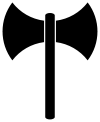LGBT Symbols
There are several different flags representing different groups within the LGBT community. Since it’s Pride Month, I thought it would be interesting to revisit the flags, the meaning behind their colors, and their origins.
There are also several symbols associated with the LGBT community. Those will be featured as well.
Gay Pride Flag –
The original Gay Pride Flag was designed by Gilbert Baker for the 1978 San Francisco Gay Freedom Celebration. It originally had eight stripes, and each color represented a different aspect of humanity and equality:
The flag was changed to seven colors, and the pink strip was removed because the fabric color was not available in large enough quantities. In 1979, the flag was changed to 6 colors, and the blue was changed to a royal blue. This is the flag we see today:
Bisexual Pride Flag –
The Bisexual Pride Flag was unveiled in 1998 on December 5th. The flag was designed by Michael Page. The flag consists of three stripes. A large magenta stripe at the top of the flag, representing same-gender attraction, a large blue stripe at the bottom of the flag representing opposite-gender attraction, and a thinner lavender stripe in the middle of the flag, a combination of the two colors, representing attraction to both genders.
The Genderqueer and Transgender Flags –
Designed by transgender woman Monica Helms, the flag was unveiled at a Pride parade in Phoenix, AZ in 2000:
The light blue stripes are associated with the traditional color for baby boys, and the light pink stripes are traditional for baby girls. The white stripe represents those who are transitioning, are unisex, or are gender neutral or have no gender. The flag is designed so that it can be hung in any fashion and still represent the transition of those who are finding their identity.
The other flag represents those who are genderqueer, Two Spirited, gender fluid, or androgynous. The flag was designed by Marilyn Roxie and consists of a lavender stripe, a white stripe, and a green stripe:
The lavender stripe is the mix of pink and blue, the mix of genders, representing androgyny. The white stripe represents gender neutrality, and the green stripe represents those who don’t identify within the traditional gender spectrum.
Leather Pride Flag –
The Leather Pride Flag was designed in 1989 by Tony DeBlase, and presented at International Mr. Leather in Chicago. The flag is comprised of alternating black and blue stripes, with a white stripe in the middle, and a heart in the upper left hand corner of the flag. Tony DeBlase left the colors of the flag up to personal interpretation.
Bear Pride Flag –
Created in 1995 by Craig Byrnes, the International Bear Brotherhood Flag was created representing the Bear culture within the gay community. The color scheme for the flag is not specific, but appears to represent diversity in color. If anyone knows the specific symbolism behind the colors, please feel free to contact me.
Other Symbols –
 The Labrys is the double-sided battle ax, the weapon of choice of the Minoans, an ancient civilization
The Labrys is the double-sided battle ax, the weapon of choice of the Minoans, an ancient civilization  who had one of the first and only all-powerful female deities. The Snake Goddess was a symbol of fertility, and the labrys has been carried as a symbol of lesbianism, popularized by Gina Gershon’s character, Corky, in the movie Bound.
who had one of the first and only all-powerful female deities. The Snake Goddess was a symbol of fertility, and the labrys has been carried as a symbol of lesbianism, popularized by Gina Gershon’s character, Corky, in the movie Bound.
The lambda is a Greek letter symbolizing unity under oppression. It was adopted by the Gay Activist Alliance in New York in 1970, and was later adopted as an international symbol for the fight for equality. 
And of course, everyone recognized the iconic symbol of the Human Rights Campaign. The equal sign in yellow set over a blue field.
The symbols representing the various subcultures withing the LGBT community are numerous, each with their own colors and meanings, but all of the symbols echo a call for equality. Remember this as you celebrate Pride this month, and remember the struggle that our predecessors went through to give us the successes we’ve seen today.






